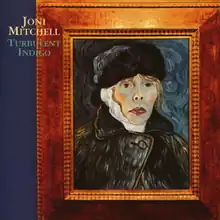| Turbulent Indigo | ||||
|---|---|---|---|---|
 | ||||
| Studio album by | ||||
| Released | October 25, 1994 | |||
| Recorded | 1993 | |||
| Studio | The Kiva (Los Angeles, California) | |||
| Genre | Adult alternative | |||
| Length | 43:06 | |||
| Label | Reprise | |||
| Producer | Joni Mitchell, Larry Klein | |||
| Joni Mitchell chronology | ||||
| ||||
| Singles from Turbulent Indigo | ||||
| ||||
| Review scores | |
|---|---|
| Source | Rating |
| AllMusic | |
| Robert Christgau | |
| The Encyclopedia of Popular Music | |
| Entertainment Weekly | B+ |
| Los Angeles Times | |
| NME | 5/10[5] |
| Q | |
| Rolling Stone | |
Turbulent Indigo is the 15th album by Canadian singer-songwriter Joni Mitchell. Released in 1994, it won a Grammy Award for Best Pop Album. John Milward, writing for Rolling Stone, wrote that it was Mitchell's "best album since the mid-'70s".[8]
The album marked her return to Warner Music (formerly WEA) distribution after her previous album, Night Ride Home, was distributed by MCA for its then-newly purchased subsidiary Geffen Records (which, prior to the sale to MCA, had distributed through WEA).
The album takes inspiration from the Dutch artist Vincent van Gogh for Mitchell's self-portrait on the cover. The song "Turbulent Indigo" references van Gogh, while describing the mental turmoil both he and Mitchell face in the creative process. Mitchell goes on to outline irrational feelings of intense rage and jealousy in the track "Borderline". The song "Not to Blame" was rumored to be about Mitchell's fellow singer-songwriter and former lover Jackson Browne, who was alleged to have beaten his girlfriend, actress Daryl Hannah.[9][10]
Mitchell also takes in non-personal issues, notably in the song "Magdalene Laundries", which recounts the sufferings of Irish women once consigned to Magdalen Asylums run by the Roman Catholic Church and made to work in the asylums' laundries. Similarly, the song "Sex Kills" referenced a number of late 20th century topical issues, including violence, AIDS, global warming and consumerism.
As of December 2007, the album has sold 311,000 copies in the US.[11]
Critical reception
Turbulent Indigo received critical acclaim. Q's Tom Doyle called the album a "welcome return to the atmospherics and acoustic terrain she's best known for", further writing that "The majority of the tracks here recall the wafting soundscapes of 1976's Hejira, with gentle, controlled feedback, Pastorius-styled bass, Wayne Shorter's tumbling saxophone patterns and walls of acoustic guitars providing a dramatic backdrop for Mitchell's bold lyrical imagery."[12]
Track listing
All tracks composed by Joni Mitchell; except where indicated
- "Sunny Sunday" – 2:21
- "Sex Kills" – 3:56
- "How Do You Stop" (Charlie Midnight, Dan Hartman) – 4:09
- "Turbulent Indigo" – 3:34
- "Last Chance Lost" – 3:14
- "The Magdalene Laundries" – 4:02
- "Not to Blame" – 4:18
- "Borderline" – 4:48
- "Yvette in English" (Mitchell, David Crosby) – 5:16
- "The Sire of Sorrow (Job's Sad Song)" – 7:08
Personnel
- Joni Mitchell – vocals, guitar, keyboards
- Larry Klein – organ, bass
- Wayne Shorter – soprano saxophone on tracks: 1, 4, 7, 9, 10
- Jim Keltner – drums on "Sunny Sunday"
- Carlos Vega – drums on tracks: 3, 4, 7
- Michael Landau – electric guitar on tracks: 2, 3
- Greg Leisz – pedal steel guitar on tracks: 7, 8
- Steuart Smith – guitar on "How Do You Stop"
- Seal – vocals on "How Do You Stop"
- Bill Dillon – synthesizer on "Yvette in English"
- Charles Valentino – backing vocals on "Yvette in English"
- Kris Kello – backing vocals on "Yvette in English"
Charts
| Chart (1994) | Peak position |
|---|---|
| Canada Top Albums/CDs (RPM)[13] | 24 |
| UK Albums (OCC)[14] | 53 |
| US Billboard 200[15] | 47 |
References
- ↑ Ruhlmann, W. (2011). "Turbulent Indigo – Joni Mitchell | AllMusic". allmusic.com. Retrieved July 19, 2011.
- ↑ Symbol means that one cut ("Last Chance Lost") is good but album is not worth the time or money. Christgau, R. (2011). "Robert Christgau: CG: joni mitchell". robertchristgau.com. Retrieved July 19, 2011.
- ↑ Larkin, Colin (2011). "Mitchell, Joni". The Encyclopedia of Popular Music (5th concise ed.). London: Omnibus Press. ISBN 978-0-85712-595-8.
- ↑ Willman, Chris (2011). "Album Review – Los Angeles Times". articles.latimes.com. Retrieved July 19, 2011.
- ↑ Forrest, Emma (November 5, 1994). "Long Play". NME. p. 46. Retrieved November 13, 2023.
- ↑ Q, December 1994
- ↑ Milward, John (2011). "Joni Mitchell: Turbulent Indigo : Music Reviews : Rolling Stone". Rolling Stone. Archived from the original on January 24, 2009. Retrieved July 19, 2011.
{{cite magazine}}: CS1 maint: unfit URL (link) - ↑ John Milward (December 15, 1994). "Rolling Stone magazine". Rolling Stone. Retrieved February 11, 2012.
- ↑ "Jackson Browne casts "Blame' back at Mitchell". Tampa Bay Times. September 30, 1997. Retrieved March 6, 2022.
- ↑ Taylor, Tom (November 11, 2023). "The "very ill" Joni Mitchell song that Jackson Browne says was "beneath her"". faroutmagazine.co.uk. Archived from the original on November 19, 2023. Retrieved November 20, 2023.
- ↑ Caulfield, Keith (December 21, 2007). "Ask Billboard". Billboard. Retrieved May 19, 2018.
- ↑ Q, December 1994
- ↑ "Top RPM Albums: Issue 2661". RPM. Library and Archives Canada. Retrieved April 7, 2021.
- ↑ "Official Albums Chart Top 100". Official Charts Company. Retrieved April 7, 2021.
- ↑ "Joni Mitchell Chart History (Billboard 200)". Billboard. Retrieved April 7, 2021.